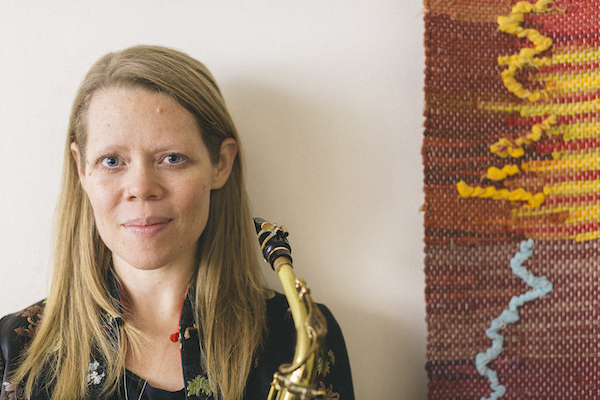Apr 2, 2024 12:59 PM
Saxophonist, Sonic Explorer Casey Benjamin Dies at 45
Casey Benjamin, the alto saxophonist, vocalist, keyboardist and producer who stamped his distinctive sounds on the…

Caroline Davis initially developed the music on Alula with drummer Greg Saunier during Brooklyn performances.
(Photo: Jacob Hand)Caroline Davis’ latest trio album, Alula (New Amsterdam), mines the anatomical world—the title referring to an appendage on a bird’s wing that aids aerial navigation—for material that can be transformed into artistic analogs. In that respect, the project resembles the saxophonist’s previous disc, 2018’s Heart Tonic (Sunnyside), which drew on cardiology.
And like her previous release, the new effort reflects her intellectual bent: Davis holds a doctorate in music cognition from Northwestern University and lectures widely on music. Taken together, the albums point to an evolving aesthetic that draws on the spirit, if not the specifics, of her scholarly pursuits.
“I’m totally more interested in putting the science into the music,” Davis, 37, said over drinks at a Brooklyn coffee shop in June. But in balancing intellect and emotion, the edge goes to the latter. For all of Davis’ logical rigor—and her willingness to deploy it in the service of her art—she makes sure that the science informs, rather than dictates, the music’s direction.
“I want to be careful about it,” she said.
Thus, even as the 11 tracks on Alula constitute disquisitions inspired by aspects of a bird’s alula, they are also poetic journeys. Her takeoff point still has been scientific inquiry.
“I started by looking into the math related to the size of the bird and the size of the alula, and I used some of those numbers to write some of the pieces for the album,” Davis explained.
“Wingbeat,” for example, is structured according to the ratio of bones to feathers on an alula, with a top row of 23 pitches assigned to her alto saxophone and a 17-pitch bottom row assigned to Matt Mitchell’s synthesizer. The pitches never line up, making for a breathlessly disorienting flight—not least for drummer Greg Saunier, who’s best known as a member of the rock world’s Deerhoof, but also has worked with jazzworld figures like Anthony Braxton and Mary Halvorson.
“It started life as an amorphous blob,” he said of his contribution to the piece, adding that his part began to take shape as he familiarized himself with the work’s contrapuntal intricacies. “I started thinking of it as a kind of James Brown thing, incredibly regular and sort of danceable.”
“Landing,” on the other hand, was clear from the get-go. Operating within an otherworldly soundscape of soaring saxophone and lush strings synthesizer, Saunier delivers a relentless, march-like beat in 7/4. The piece, in fact, grew out of Davis’ almost mystical fascination with the number 7.
“I wanted to create this atmosphere like you were flying through space,” the bandleader said, “but I wanted to use this very specific number. There are so many equal parts inside of 7, yet it’s an odd number. It’s a prime number. It’s also this ‘lucky 7.’ I was relating it to how complicated the structure is and putting it inside a space that is beautiful and ethereal.”
The piece gains power from its spare framework, achieving maximum impact by subtle sonic shifts, rather than dramatic displays. “I remember having tears in my eyes as it was happening,” Saunier said, recalling his reaction during the December 2017 recording session at Figure 8 studio in Brooklyn.
Initially, the album’s music was developed by Davis and Saunier during concerts in small spaces throughout Brooklyn. Mitchell joined the two for a smattering of gigs before the tracks were laid down. Having employed Davis with his band Sprees for shows at The Stone in 2016, Mitchell was prepared for the understated profundities that awaited.
“It’s almost unassuming in a certain way,” Saunier said of Davis’ music. “It’s not like, ‘Check me out, I’m super-deep.’ But then you listen; it’s a very personal exploration of things you thought you knew.”
Davis’ scientific explorations lately have turned to neurons. For that project, she’s introduced a kinetic element into her solo performances. Hopping a bit onstage, gauging how the movement alters the rush of air through her horn, Davis’ immediate goal is intellectual: “How can I move like a neuron would move at the micro level—these little chemical reactions involving potassium and sodium?”
But, like all her efforts, the ultimate objective is discovering an emotional truth: “How does it feel?” DB

Benjamin possessed a fluid, round sound on the alto saxophone, and he was often most recognizable by the layers of electronic effects that he put onto the instrument.
Apr 2, 2024 12:59 PM
Casey Benjamin, the alto saxophonist, vocalist, keyboardist and producer who stamped his distinctive sounds on the…

“He’s constructing intelligent musical sentences that connect seamlessly, which is the most important part of linear playing,” Charles McPherson said of alto saxophonist Sonny Red.
Feb 27, 2024 1:40 PM
“I might not have felt this way 30 to 40 years ago, but I’ve reached a point where I can hear value in what people…

Albert “Tootie” Heath (1935–2024) followed in the tradition of drummer Kenny Clarke, his idol.
Apr 5, 2024 10:28 AM
Albert “Tootie” Heath, a drummer of impeccable taste and time who was the youngest of three jazz-legend brothers…

“Both of us are quite grounded in the craft, the tradition and the harmonic sense,” Rosenwinkel said of his experience playing with Allen. “Yet I felt we shared something mystical as well.”
Mar 12, 2024 11:42 AM
“There are a few musicians you hear where, as somebody once said, the molecules in the room change. Geri was one of…

Henry Threadgill performs with Zooid at Big Ears in Knoxville, Tennessee.
Apr 9, 2024 11:30 AM
Big Ears, the annual four-day music celebration that first took place in 2009 in Knoxville, Tennessee, could well be…